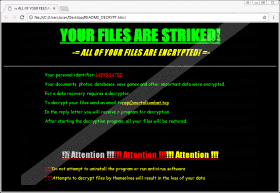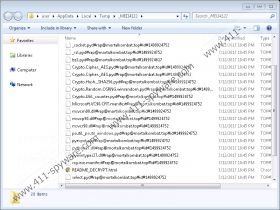Striked Ransomware Removal Guide
Striked Ransomware is a recently discovered ransomware-type computer infection that is dedicated to encrypting your files. Its creators want to encrypt your files to compel you to pay a ransom to decrypt them. Needless to say — you should not comply with their demands because they may not keep their word or the sum asked of you can be too high. Therefore, you should look into the possibility of removing this ransomware instead. In this short article, we will discuss how this program works, how it is distributed and how you can get rid of it. If your PC has become infected with it, then please continue reading.
Striked Ransomware seems to be one of a kind ransomware as it bears no resemblance to other ransomware we have tested. Obviously, its developers are unknown because they are cyber criminals and hide in the shadows to avoid trouble because the development of programs such as this one is illegal.
Our analysis has revealed that this ransomware is most likely distributed with the help of email spam. Apparently, its developers may have set up an email server dedicated to sending bogus invoices and receipts to unwary users who open an attached fake PDF document that is this ransomware. As a result, Striked Ransomware enters a user’s computer by stealth and starts doing its dirty work.
The encryption algorithm used by Striked Ransomware is unknown, but it is likely that it uses either an AES or RSA encryption algorithm or a combination of the two. This ransomware is currently un-decryptable as there is no free decryption software. It creates a public encryption and private decryption keys and the decryption key is sent to its remote server and stored. This ransomware starts encrypting your files immediately after infection. Testing has shown that this program is set to encrypt all file types, so nothing will work once the encryption is complete. It will encrypt your documents, pictures, videos and even executable files, so none of the programs on your PC will work.
While encrypting the files, Striked Ransomware is set to append the default file extensions. It adds an email address that you are supposed to message and also adds a unique user ID at the very end. For example, a JPG image file “picture.jpg” will be modified to look like “picture.jpg#rap@mortalkombat.top#id#1499924752.” The email address is always the same, but the unique ID number is different for each user.
Once the encryption is complete, this ransomware will drop a ransom note named "README_DECRYPT.html" that says that all of your files have been encrypted and that you need to send an email to torap@mortalkombat.top. Then, the cyber crooks will send you a decryption tool, but not before you pay a ransom which is not mentioned in the ransom note. The sum asked for the decryptor may not be worth your files, so you should consider your options.
As you can see, Striked Ransomware can encrypt your files and keep them that way if you do not pay. However, the cyber criminals might not keep their end of the bargain, and you may only waste your money by attempting to pay the ransom. We recommend that you remove this malicious application as soon as possible using an anti-malware program such as SpyHunter or delete it manually.
Manual Removal Guide
- Hold down Windows+E keys.
- Type the following file paths in the address box and press Enter.
- %TEMP%
- %USERPROFILE\Downloads
- %USERPROFILE\Desktop
- Find the randomly-named executable.
- Right-click it and click Delete.
- Empty the Recycle Bin.
Striked Ransomware Screenshots:



